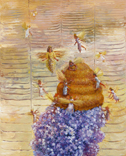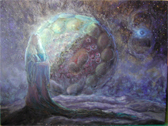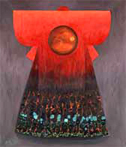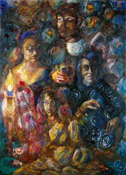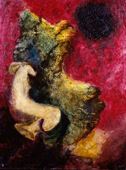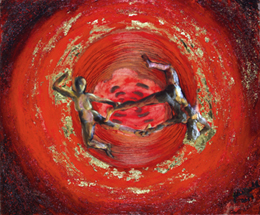

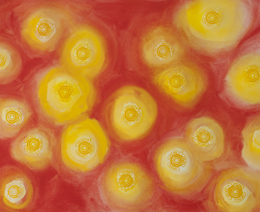
...Julie Newdoll merges life science and culture, myths and molecules in her
paintings, music, journal covers and science games.
Shakespeare:
A Mirror up to Science
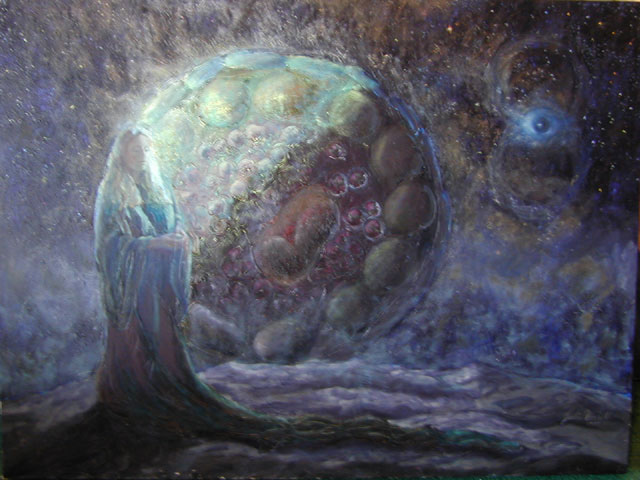
A woman is born with thousands of eggs (oocytes) at birth. During her lifetime, she will ovulate only about 400 eggs. The rest of these eggs seem to self-destruct via the mechanism of apoptosis, or programmed cell death. What causes these eggs to die? If they died at a constant rate until menopause, a woman would be losing two eggs a minute. It seems, however, that we lose fewer eggs during the early part of our life, and this egg loss gets faster and faster as a woman ages. The oocyte in the background is like a waning moon. Egg loss has reached the tenth hour of her biological clock.
Inspired in part by the paper "Oocyte Apoptosis: Like Sand through an Hourglass", Yutaka Morita and Jonathan Tilly, Developmental Biology 213, 1-17, 1999. Figure originally in "Prolongation of ovarian lifespan..." by Perez et. al, Nature Genetics. vol21 #2, 1999. Special thanks to Chris Gralapp.
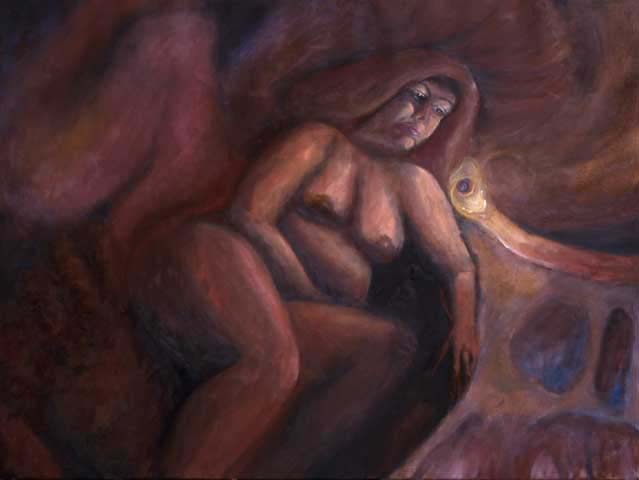
Watching the Clock Gene: Woman Reclining near the Suprachiasmatic Nucleus: 33" x 44", 2000. Available for purchase, $550.
The Circadian Rhythm, the clock inside our head that dictates our daily cycle, is controlled mainly in a place inside the brain called the Suprachiasmatic Nucleus. Genes such as the Clock gene reside in this area, and in the back of the eye. Light trains this clock. It is regulated by the buildup and breakdown of proteins during the day and night. We are quickly discovering the means for controlling our Circadian Clock. Inspired in part by the paper "Functional Identification of the Mouse Circadian Clock Gene by Transgenic BAC Rescue,Marina P. Antoch, et. al., Cell, Vol. 89, 655-667, May 16, 1997.
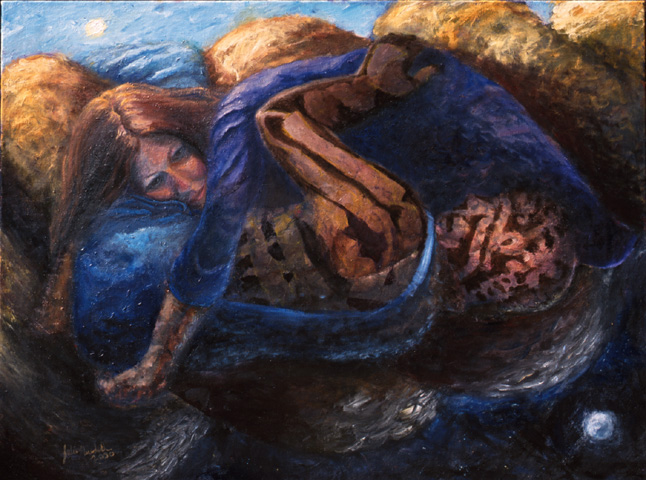
Clock and Bmal-1 are proteins which are part of the circadian cycle in mammals. Their production is cyclic throughout a 24 hour period. When there are enough of them, they begin to bind to each other. In this state, they can then bind to DNA, causing a third protein to be produced, mPER, or period. It is suspected that this gene product ceases the production of CLOCK, BMAL-1, or both. This kind of negative feedback loop can be found in the internal clock of insects, bacteria, and mammals.
Weaver Girl and Ox Boy are from an ancient Chinese myth, one version of which follows:
Weaver Girl and Ox Boy are the characters which are used to celebrate Chinese Valentines Day, and were originally called Weaver Maid and Draught Ox:
East of Sky River is Weaver Maid, the daughter of God in Heaven.
Year by year she toils and slaves with loom and shuttle till she
finishes weaving a celestial robe of cloudy silk.
God in Heaven pitied her living alone, and allowed her to marry Draught
Ox west of the river. After they married she neglected her weaving work.
God in Heaven grew angry and punished her by ordering her to return to
the east of the river, letting her make one crossing each year to be with
Draught Ox.
(Erh ya yi, Ts'ung-shu chi-sh'eng), Chinese Mythology, and Introduction, by Ann Birrell, 1993, The Johns Hopkins University Press, ISBN 0-8018-4595-5
Scientific reference: "A molecular mechanism regulating rhythmic output from the suprachiasmatic circadian clock",Jin X, Shearman LP, Weaver DR, Zylka MJ, de Vries GJ, Reppert SM, Cell. 1999 Jan 8;96(1):57-68.8.

Beginning with an electron microscope image of pits on the surface of a cell, this painting evolved. Microscope image supplied by Dr. Dan Friend.
Programmed
Cell Death:
Apoptosis



